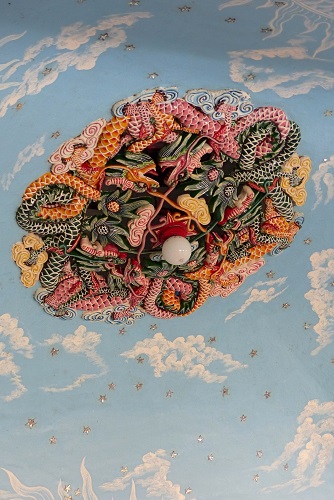Ever heard of a religion formed after somebody spoke to God at a seance? Around 100 years ago, a Vietnamese civil servant received a message from a spirit during a seance. Befriending the spirit, they spoke regularly and he finally concluded his new chum, Duc Cao Dai, was God. He introduced some friends to his new acquaintance and in 1926 Caodaism was officially founded. The Cao Dai Holy See is the centre of this new Vietnamese religion.

The Great Divine Temple
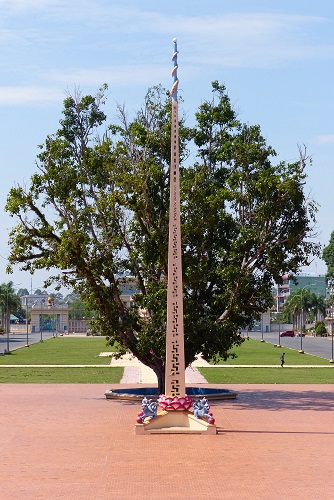
Cao Dai Holy See Complex
When Caodaism first appeared, religious leaders were allowed to tax the local people. The Cao Dai took advantage of this, collecting enough money to build their headquarters, the Cao Dai Holy See. Although the Great Divine Temple is best known, the complex also includes a school, offices and a hospital specialising in traditional herbal medicine.
It hasn't always been plain sailing though. The Cao Dai spoke out against communism during the Vietnam War. This backfired when South Vietnam lost the war and a new communist government took over. Caodaism was promptly banned and remained illegal in Vietnam for over 20 years. Reinstated more recently, it's now the third largest religion in the country with several million followers.
Entering the Cao Dai Temple
We added our trainers to the disorganised sea of shoes that was expanding across the tiles. Hurrying across the pavement in our socks, we chased after our tour guide as he disappeared around the front of the temple. Our whole group, men and women both, then trooped in through the men's entrance.
When we came to leave, we exited by the same route. As we tried to walk across in front of the temple however, a whistle trilled sharply. This was accompanied by incoherent shouting and vigorous arm waving. We got the idea that this area was off-limits during worship. The preferred route was through the inside of the temple, surely more disruptive than walking around outside.

The Band
Once inside, we weaved our way past the devotees sitting on the floor, the landings and even the stairs. We joined other tourists on a crowded balcony overlooking the interior of the temple. Our vantage point in the upper levels was also the perfect place to watch the musicians, who were seated in a circle right next to us. As they began to pluck and bow at the strings, the choir broke into gentle song while more worshippers filed silently into the main hall.
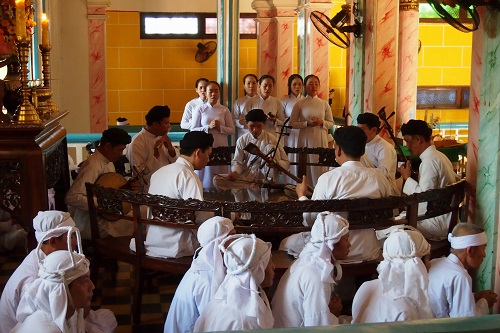
The 12pm Prayer Session
Clad all in white, the worshippers effortlessly aligned themselves into perfect rows. Women filled the left side of the temple, while the men sat on the right. Intermittently a gong chimed and everyone bowed forward in unison. Otherwise they were motionless for the entire time we were there.
Cao Dai devotees follow a strict routine of prayer and meditation with four prayer sessions each day. They are also expected to be vegetarian but only for 10 days a month.


Cao Dai Hierarchy
Similar to Roman Catholicism, the Cao Dai have a strict hierarchy. They have priests, cardinals and even a Pope, although that position has been vacant for some time now. The one and only Cao Dai pope fled to Cambodia seeking political asylum in 1955 and died there just a few years later. He has never been replaced.
We noticed a few men at the front were wearing brightly coloured robes. These were the priests and other high ranking Cao Dai. The Cao Dai believe "all religions are one" and they combine the principles of several major religions in their practices. The robe colours represent three major influences in Caodaism: red for Confucianism, blue for Taoism and yellow for Buddhism. This doesn't apply to the higher ranking females though who still wear white as a symbol of purity.
Moving Up The Ranks
The floor of the main temple is stepped representing the nine steps to heaven. Longer serving Cao Dai sit on the higher steps with the highest ranking closest to the front. Each step is marked by gaudy dragon entwined pillars.


Cao Dai Saints
We found this painting of Cao Dai saints signing a contract with God. It reads "God and humanity. Love and justice." Bizzarely, one of these saints is Victor Hugo.
Caodaism is an all encompassing religion and they include Buddha, Jesus and Muhammad among their saints. Even Joan of Arc and Louis Pasteur made the cut. Vietnam was under French control in the early days of Caodaism, which may explain the French influence.
The Divine Eye
Appearing all over the Cao Dai Holy See, the Divine Eye represents God. It serves as a reminder that God is all-seeing. There's even a huge globe at the front of the temple painted with a giant eye that watches over the worshippers.
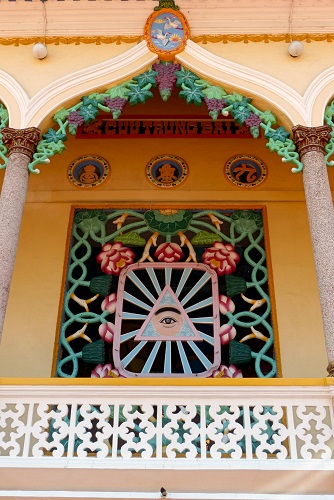
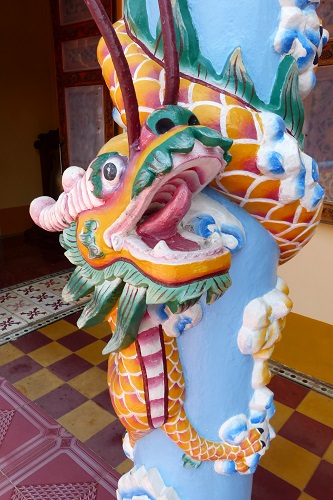
How To Get To The Cao Dai Holy See
The Cao Dai Holy See is near Tay Ninh in Southern Vietnam. We visited on a day trip from Ho Chi Minh City, around 90km away.
It is probably easiest to join a day tour from Ho Chi Minh City. This can be combined with a visit to the Cu Chi Tunnels used by the Viet Cong soldiers during the Vietnam War. These tours often aim to arrive at the Cao Dai Holy See in time for the 12pm prayer session.
Cao Dai Holy See Travel Tips
Dress modestly when visiting the Cao Dai Holy See. You will be expected to remove your shoes before entering the temple.
Tourists are only allowed in the area around the stairs and balcony at the back of the temple. You will be allowed to take photos from here.
The Cao Dai pray 4 times a day at 6am, 12pm, 6pm and midnight. Prayer sessions at the Cao Dai Holy See are held at these times.
